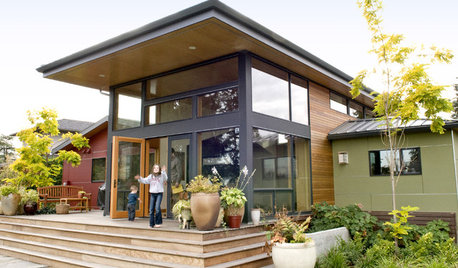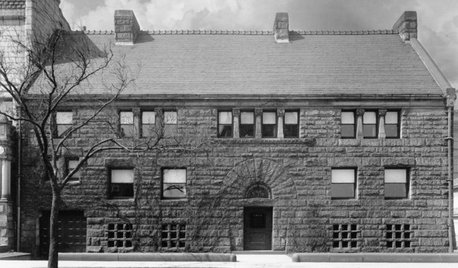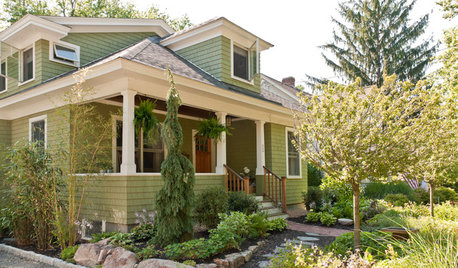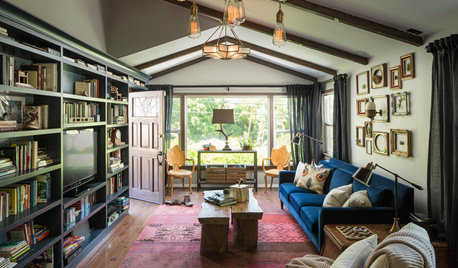What to be aware (or beware) of in house built in 1933?
My husband and I are thinking of relocating to a town and neighborhood that he grew-up in. It's just 30 minutes away and near one of our children, and more importantly, our first grandchild! We have been in our current home for almost 9 years. You will remember me as NewHomeBuilder from when I first registered after building our current home.
So, this neighborhood is nothing but older homes. We have not lived in an older home since we lived in the same town/neighborhood over 25 years ago. Our home at that time was 42 years old. We did some major work (including an addition) and some minimal work before moving to a brand new house a few years later. Since then, all but one of our houses has been brand new that we built.
On Saturday, we are going to look at a home built in 1933. We had always admired this home, so called the owners to see if they would be willing to sell. Admittedly, we heard through the grapevine that they might be thinking about it. They said "yes"! They have lived in the home for 37 years and are in their 80's. The yard is immaculate, but still needs some work because of too large shrubbery. More on that at another time. I am assuming that the inside has been well taken care of, but not updated in many years.
After talking to friends that have been in this house, we know there is wallpaper in many rooms. The kitchen is on the small side, but is adjacent to a cozy breakfast room with fireplace. We know that a kitchen redo will be in order and would also knock down walls. Bathrooms would most certainly need to be redone. There is a den addition with some siding that we are not sure we will like, so possibly work to do there. We would also need to add a Master bedroom and bath on the main floor. We are almost 58 and 63 and the days of going up and down stairs is not too appealing.
So my question is for old home lovers and renovators. What should we look for or ask about when touring the home on Saturday? Any regrets renovating an older home?
We are thinking that the walls will be plaster. Replace with sheetrock or patch?
We are anticipating rewiring and plumbing. If not just in the areas to be renovated, the whole house. Much easier to do if walls are taken down.
Comments (29)
tibbrix
8 years agolast modified: 8 years agoMy house is 1880. The big things are making sure structural beams are all sound and that sewage pipes are also sound, no cracks, etc. Foundation should be in very good shape; sills not rotted. Look for water rot, stains on ceilings, on the outside walls, etc., indicating leaks.
Unless it truly wasn't maintained well, older homes were, IMO, built better than are homes nowadays, much more solid.
Also ask about any critters living inside the house, i.e.: mice, squirrels…
Find out about the insulation that is in the house, or not.
Does it need new, more energy efficient windows?
What kind of condition is the chimney in, assuming it has a wood-burning fireplace.
is any paint in the house original to the house so might contain lead?
Nothing Left to Say
8 years agoPlaster is awesome. Keep it where possible.
Wiring and plumbing are always a question. We are getting rid of the last of the knob and tube wiring in our 1926 house right now. Expect that to run thousands. Once we finish this kitchen and bath remodel we will have replaced all the plumbing. That's also thousands.
Otherwise, the usual stuff that could be an issue with any house that isn't brand new--roof, furnace, air conditioning, water issues in basement.
If it has original wood windows, investigate carefully before replacing. Plenty of sources will argue that they are more durable and nearly as efficient as replacement windows (I have seen the math run that the lifespan of replacement windows is shorter than the amount of of time it takes to recover the cost.). Storms on top of original wood is an option to consider.Related Professionals
Belle Glade Interior Designers & Decorators · Fort Smith Interior Designers & Decorators · Gloucester City Interior Designers & Decorators · Carlsbad Furniture & Accessories · Long Beach Furniture & Accessories · Reno Furniture & Accessories · Encinitas Furniture & Accessories · Highland Park Furniture & Accessories · Lake Arrowhead Furniture & Accessories · Zionsville Furniture & Accessories · Immokalee Custom Artists · Fort Washington Lighting · Saint Petersburg Lighting · Campbell Window Treatments · Westfield Window Treatmentsjlc712
8 years agoHow exciting for you! I remember when you were working on your current house! I hope it all works out well for you. Old houses can be wonderful, and just have a different feel and quality that you usually can't replicate with new construction. We remodeled our house, and although we made tremendous improvements, there are still some things that drive me crazy.
I'd look at-- Furnace, a/c, insulation; plumbing; electrical (including how many outlets per room); roof; windows & screens; structural issues; gutters, grading/drainage. Closet/storage space. If the bathrooms you want to redo have tiled walls, they were likely done with tile set with cement/mesh, which is a big old mess to remove. Sprinkler system, condition of driveway/sidewalks.
Are you walking through with the current owners? That might be very helpful, but it also might prevent you from digging around as much as you'd like.
bpath
8 years agoLead paint and asbestos. If you do anything major, you might need to encapsulate. Dry rot. Small closets.
Love 1930s houses, so pretty! Share pictures if you can!
tibbrix
8 years agoAgree w/crl. If the windows are in good shape and the old wood kind the wood muntins, consider keeping them. There are lots of ways to insulate windows in the winter - shrink wrap comes to mind. But you want to know if they need to be reglazed (some of mind did).
sreedesq
8 years agoI second all of the above, especially plumbing, electrical, and insulation concerns. One issue I will mention as a recent remodeler is the struggle to find good people in my area who still have the knowledge to work on older homes in terms of non-pvc plumbing, copper gutters, plaster etc. Where I live in a small town, that population of craftsmen is sadly dying out, so I'm not sure where you live but making sure you have good people at hand to help is a big part of a successful Reno. Also, beware when you open any walls of the snowball effect in an older home lol. Please keep us updated and best of luck :)
jlc712
8 years agoBeing able to find craftsmen and good contractors is an excellent point. That is something we really struggled with in our rural area, and we ended up with a contractor who was way over his head. We had many struggles because of that issue. "What, you don't want orange peel drywall texture, vinyl porch railings, beige paint in every room, and a cultured marble bathroom? I've never done it any other way!" It was rough going.
User
8 years agoI agree 100% about living in the home for 1 yr before making changes. There is nothing wrong with knob and tube electric unless you live a life filled with plug in appliances. It's the overload that usually does k & t in. Galvanized pipes are fine except after 75 yrs they are sure to have calcium build up inside which slows down water pressure. Keep plaster! Forget modern sheetrock if you can. The soundproofing of plaster is wonderful! Wood is the best insulator for windows. Check them out making sure they aren't painted shut. Check for gaps between the exterior doors and doorframes. If there is carpet, ask about hardwood underneath. We're in a 1919 home, renovating our main bathroom now, and removing a HD special. 10 yrs waiting to be rid of 12 in square tiles!!! Back to the original daisy hex tile floors and white subway tiles with knife edges..no beveling!
All the other advice given is great!
Nothing Left to Say
8 years agoKnob and tube has some pretty real drawbacks. Potentially including difficulty getting insurance.
Galvanized pipes carry some risk of increased lead exposure depending on the circumstances. And lack of water pressure is annoying at every shower.
I wouldn't say that you must replace both instantly. But if you are planning on a new kitchen and other substantial work, you should factor in the possibility of needing a lot of electrical upgrades, etc. We have done the plumbing and electrical work in conjunction with other projects. When our current project is finished the last bit of knob and tube will be gone and the last bit of old plumbing will be gone as well.
I agree that I would try to live with the existing layout in an older home for a while before tearing down walls. We have found that we love having separate rooms with solid wood doors between them. So much quieter.nhb22
Original Author8 years agolast modified: 8 years agoVery good points and way more than I expected to hear! :)
"is any paint in the house original to the house so might contain lead?"
I feel sure that there is original paint in that house, though covered up.
Happy - We would be buying an old house because we like the character of an old house and would want to keep as much original as we could. However, sometimes there is a need for changes for better living arrangements, such as a larger kitchen for the family to gather. Believe me, any changes would be tastefully done.
Gooster
8 years agoOur home is from 1937. To add to the suggestions above:
a. Check to see if the electrical service panel has been upgraded. Fuses are a PITA.
b. I agree about the galvanized pipes; we've replaced most of ours with copper, especially the kitchen.
c. Keep the plaster and patch where possible. It's OK to use new construction materials on any addition, you just have to work to replicate the original texture. Purists would use plaster and lathe, but it can be challenging and expensive.
d. Of course many things will be caught during an inspection, but take a look at the foundation and for signs of sagging beams. Foundation work can be really expensive -- we did over 20K in structural upgrades..
e. If they are on sewer, ask if the line has been replaced. In my area, Orangeburg was a plague. It basically was a sewer pipe made of compressed wood fiber and pitch. Slow drains are a sign.starnold
8 years agoWe've renovate four homes all built between 1925 and 1930 and I agree with all of the advice given above! Snowballing is when you start on a reno- say to upgrade the bathroom, open a wall to reset a valve and discover extensive dry rot, so now you're tearing out and redoing floors and walls. Or when your go to fix exterior siding and discover the entire sill plate needs to be replaced, or upgrade some plumbing and the increased pressure starts leaks on the remaining old pipe. Deferred maintenance is a major issue in old homes so you want to ask a lot of questions about what has and hasn't been done, especially if you are doing a real estate transaction without a realtor or disclosure documents.
Do your due diligence by getting a home inspection with someone who really knows the ins and outs of old houses, and make the offer contingent on the results. Check to see if any permits have been pulled for previous work; definitely get a sewer scope inspection; the furnace and water heater are other concerns; insulation- if it hasn't been upgraded an old house can be very uncomfortable in extremes of weather ; mold behind wall paper and paneling can be another unhappy surprise. If you have a GC in mind or even just a good friend who knows construction also have them crawl around the house, attic, basement, crawl spaces, a lot of things can be revealed that way that an inspector might miss, or in some states, not be allowed to delve into. On one occasion my GC moved lumber stacked across the crawl space and discovered the entire living room was supported on car jacks, on another that the floor of the main bathroom was dry rotted throughout.
Old homes, if you are willing to take on the maintenance, are marvelous and nearly anything can be remedied, but way better to be forewarned than surprised with bad news - and a contingency fund is a good idea too.
Annie Deighnaugh
8 years agoI was going to suggest making sure you had an excellent building inspector, (there are plenty of mediocre ones) or a good contractor who might do renovation for you take a look....the problem is always the unexpecteds that are buried in walls, underground and behind things. And make sure your price reflects all of that. If you've ever watched shows like Love It or List It, you'll see how many times an unexpected shows up and eats well into the reno budget so other things have to be given up.
nhb22
Original Author8 years agoYes, we are expecting most if not all of these situations to come up and will hopefully have a hefty budget to cover them.
Snowballing...Don't say that to a young person. Google says something different. YIKES!!! Let's just say cost start building -up.
Oh, and on the comment to live in the house a year before doing anything, that will not happen. We plan to buy and renovate while we are still living in our "new" home. We have lived through renovation and never want to do that again. We plan a year for renovations.
DH is a banker and has access to a few good inspectors. We also have an excellent contractor...neighbor and friends. The people we would be buying from are individuals that we have past relationships with and they are well known in the community. We also have many realtor friends that we would enlist the help of a contract.
We are the 3 or 4th couple on a list to look at the home. The owners are letting us look first because we were the first to call when we heard the house might be for sale. The others had called months and years before just asking that they be called if the house ever went on the market.
Another thing that we are going to take into account is the sale price when adding the approx. renovation cost. Although the house is one of the largest and more stately homes in the neighborhood (certainly not the only one) we do need to be careful not to have a home that is priced well over the market value of others around it when we think of selling 15-20 years down the road.
Thank you again for all the good advice. I am making a list to take tomorrow. You should know by tomorrow night if the house is a hit or miss!
IdaClaire
8 years agoYou've already received excellent, comprehensive advice - so I'll just add my voice to those saying be sure to have the plumbing thoroughly checked. We did have an inspection on our 1940 home before moving in, but apparently it was cursory and did not reveal the major issues with the old sewage pipes that had us coughing up $6,500 for repairs less than a month after move-in.
nhb22
Original Author8 years agolast modified: 8 years agoAuntjen – From reading a post of yours, sounds like we may be switching places with the type of homes we have.
“There is
nothing wrong with knob and tube electric unless you live a life filled with
plug in appliances.” OOOPS!!!“We had many struggles because of that issue.
"What, you don't want orange peel drywall texture, vinyl porch railings,
beige paint in every room, and a cultured marble bathroom? I've never done it
any other way!" It was rough going.”jlc712 – Not
quite sure what you are saying...the wording has me confused? And what
is orange peel drywall? Sounds like
something added in later years???Imhappy&Iknowit
IOWA zone 6b – Meant to add earlier that there are no new houses in this
neighborhood. Nor are there any lots (at
least not for sale.) It’s a very large, planned, older neighborhood. Most of the homes have changed hands a few
times over the years. Some have been let
go. :( Some stay the same with upkeep. Others have been renovated, added on to,
etc. Some good, some not so good. :( We plan to keep the house as close to original as our personal
taste and needs would allow. We would
also keep in mind what the neighbors would like or think, and of course, keep
the current owners in mind when making changes.
They are, however, moving out-of-state and may never come back to see
the house.Below are my notes and list taken from everyone that have been so helpful. I've also added some of my own questions. Let me know if there are others we haven't thought about. ( Leaving at 4:00!)
I must say that I am a bit overwhelmed, but thankful to you that we know what we might be getting into. I happened to go in an older home yesterday that belongs to a young couple in town. They have been in it for about 7 years. I saw it before they bought the house. I was shocked that it had not been updated! It was scary and all I could think about was how had the couple lived in it the way it was!
Notes & Questions:
“Older homes were built better
than are homes nowadays, much more solid.They can be wonderful, and just
have a different feel and quality that you usually can't replicate with new
construction.”“Plaster is awesome. Keep it
where possible.”“If house has original wood
windows, investigate carefully before replacing. Plenty of sources will argue
that they are more durable and nearly as efficient as replacement windows (I
have seen the math run that the lifespan of replacement windows is shorter than
the amount of of time it takes to recover the cost.). Storms on top of original
wood is an option to consider.”“If the windows are in good shape
and the old wood kind the wood muntins, consider keeping them. There are lots
of ways to insulate windows in the winter - shrink wrap comes to mind. But you
want to know if they need to be re-glazed.”“Galvanized pipes are fine except
after 75 yrs they are sure to have calcium build up inside which slows down
water pressure. Keep plaster! Forget modern sheetrock if you can. The
soundproofing of plaster is wonderful! Wood is the best insulator for windows.”“or upgrade some plumbing and the
increased pressure starts leaks on the remaining old pipe.” YIKES!“Check to see if any permits have
been pulled for previous work; definitely get a sewer scope inspection; the
furnace and water heater are other concerns; insulation- if it hasn't been upgraded
an old house can be very uncomfortable in extremes of weather ; mold behind
wall paper and paneling can be another unhappy surprise.” L“Getting rid of knob and tube wiring will run thousands. Plumbing is also thousands.”
Structural
beams sound…not sagging, rotted or broken?Look for
jacks or foundation uplift work.Foundation, base
sills? Look for water rot.Check for
gaps between the exterior doors and doorframes.Look for stains
on ceilings, outside walls, etc., indicating leaks.Sewage pipes
are sound, no cracks, etc.Problem with
critters living inside the house?What type of
insulation that is in the house, or not?Condition of
windows or do they need replacing? Painted shut?Condition of
chimney’s. Wood-burning, gas, both?Condition of
brick on house (cracks, chips)?Lead in
paint? Oil based? (check for chipping)Plaster
shape?Asbestos-fiber
shingles…Does house need new roof?Guttering?
Grading and
drainage problems?Water issues
in basement. Sump pump?Electrical
condition...how many outlets per room?Electrical service
panel. Upgraded or Fuses?Water pressure/slow
drains in plumbing?Bathrooms
walls …with tile set with cement/mesh? (big mess to remove)Feel for
spongy floors in bathrooms and kitchen. (wood rot)Has sewer
line been replaced? Or is it the dreaded
septic tank?What type of
furnace, air conditioning, heat pump?
Does it need replacing?Asbestos in
furnace duct insulation?Condition of
garages, driveway and sidewalks?Has the home
had yearly termite inspections and/or ever had Termites?Amount of storage/attic
space?History of the house...style, original owners, architect?
Significance
of two shutter colors/styles? (Black Louvered on top windows
and White Paneled on bottom)Can shutters
be changed? Brick painted?What is the
significance/history of the wood walls in new addition? (Paint?)Ceiling heights?
Type of
doors?Hardwood
throughout…type?Number of,
age, and maintenance cost of Boxwoods?Sprinkler
system?Alarm System?
tibbrix
8 years agoYou know, if the windows need to be replaced, you CAN still get wood windows with the wood muntins, just like the old ones, but with more efficient glass. They'll cost you a fortune, and you'll have to look for them, but IMO, they're total worth it.
starnold
8 years agolast modified: 8 years agoOne more- if the home was heated with oil, has the tank been decommissioned and certified that it doesn't leak.
Nothing Left to Say
8 years agolast modified: 8 years agoReplacement windows with wood mutins are a little complicated. For us, we had to go double pane to be allowed to install new windows--code requirements for energy efficiency. Going double pane meant that either the mutins are really just an applied grid on both sides of the window with no separator in between or they put a spacer in the middle--usually metal, which you can see if you look. Or the dimensions of the wood mutins have to change to support two panes of glass. None of these options look the same as original single pane windows with mutins. Also many details of original windows (ogees, etc) have been dropped from mass-produced windows.
There definitely are wood replacement options out there, but they may be more expensive and may not match orginial windows. And/or you may need to do some work to source something closer to the original windows in looks, if that matters to you.
If original windows in an older home are in good condition, I would really consider just keeping them. If the home has been well-maintained, the windows probably are not going to be a big issue, in my limited experience.
The exact cost of replacing knob and tube wiring, if the house has any (it may have already been replaced), will vary. For us all that was left on knob and tube was lighting and a few electric outlets. We had a newish electrical service box with plenty of room for new circuits when we bought but it was not permitted and not to code so we paid about $2000 to replace it and make it to code. We are now removing all knob and tube from the remainder of the house during a kitchen and bath remodel. That's costing $3,100 for the electrical work outside of the kitchen and bath.
We ran a new sewer line when we bought the house. I don't remember that cost separately as it was part of also installing a new furnace, new hot water heater and adding a sump pump. All of that work totaled around $20,000. When we remodeled the master bathroom we also had all new piping put in, except for the pieces that connected up to the other bathroom and the kitchen (we knew we would replace those when we remodeled those rooms). That was an additional $3000 separate from the bathroom remodel costs.
It definitely adds up. But we knew these things needed to be done (except for the not-to-code electrical box which the inspector missed!) and they were considered in the price of the house. I should note that we are in a very HCOLA.
nhb22
Original Author8 years agoHCOLA?
Water heaters...that's one we forgot about. Thank you.
"if the home was heated with oil, has the tank been decommissioned and certified that it doesn't leak."
Good one!
OK, winding this down. Printing out my questions.
tibbrix
8 years agocrl, I put two five-feet-tall windows in my house when I bought it. The house has the old wood windows with individual 6X8 panes separated by wood muntins. I wanted so badly to get the five footers like that, but I couldn't find them anywhere, and I'm sure I wouldn't have been able to afford them. I knew I absolutely was NOT going to get the kind where the muntins pop off. I got the kind you describe that has the metal in the middle. I'm fine with them, but I definitely would have preferred the authentic kind.
But, I know you CAN still get them. Maybe not through a major manufacturer like Andersen or Pella, but they are out there. I know people who've gotten them. But I'd rather have NO munitions than those flimsy pop-off things.jlc712
8 years agoSorry, NHB, I didn't word that well. I was a bit lost in remembering all the difficulties we had in remodeling. The part in quotes is what our contractor said to us, when we wanted things done in a historically accurate way, rather than how he'd typically done things.
Orange peel texture is a cheap, quick way of finishing drywall. Instead of sanding the surface smooth, they spray on a product that leaves a texture that is slightly bumpy, like an orange peel. It camouflages the lack of finish work.
You have an excellent list to work from. Starnold's reminder about oil tanks for heating is excellent. It can be a terrible, expensive problem. We had an oil furnace, the oil tank valve failed, and we had hundreds of gallons of oil leak into the ground along and under our foundation. We went through months of being out of our house, battles with the insurance company, and a huge cleanup, excavation of soil, environmental testing and remediation, and replacing our furnace.
Good luck! Let us know how it goes!
nhb22
Original Author8 years agolast modified: 8 years agoHCOLA= high cost of living area
Got ya! Your figures were very helpful. ;)
tibbrix - When we built a home many years ago, with got the insulated type that had screw in munitions that were very hefty! I believe they were Pella.
OK, printing out my questionaire and leaving now. I'll report back probably tomorrow.
jlc712 - Thank you for the explanation and your oil story.
Gooster
8 years agoRegarding true divided light windows, the manufacturer list has dwindled. Kolbe is one brand with wide distribution. However, since they are double pane you still end up with a gap between the panes and they end up looking not much unlike the products with a foam or metal spacer.
We bought the Pella Architect series with the divided light spacer between the interior and exterior wood muntins. We also got integral rollup up screens to replicate the originals. The originals were steel on the bottom floor and wood on the top -- we replaced all with wood with an ogee detail that matched the original 2nd floor wood windows. They even offer pushout casements like the originals. Marvin has a similar offering. This all comes at a price --- our order had the dubious distinction of setting an office record for an order of replacement windows. Talk about expenses sno..... ummmmm.....escalating.nhb22
Original Author8 years agoI will write more tomorrow when I have time, but wanted to let everyone know that the house will be a NO GO because of the asking price...$250,000 MORE than the highest Zillow, Trulia and Realtor estimates. I am in mourning. :( My husband was even getting excited about the possibilities of the home...down to planning where the Master bedroom addition would be (when I couldn't figure out a place to add it.) If we paid over the top price for the house there would be little money to make improvements, much less add a wing and improve the kitchen. More later!
Nothing Left to Say
8 years agoSo sorry. Good luck finding a different, equally wonderful place at the right price m





















User